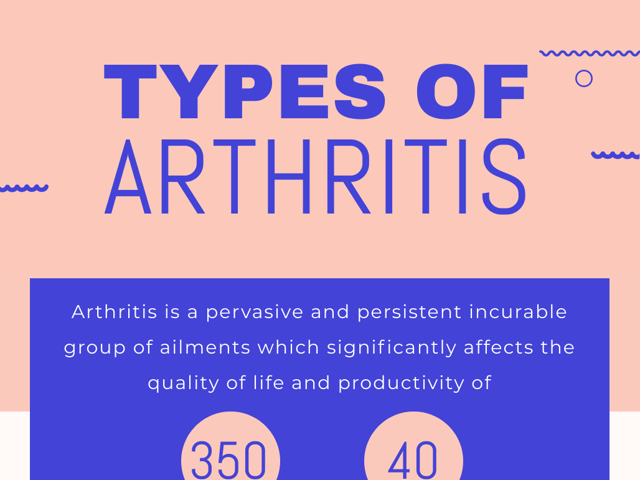
Types of Arthritis
Arthritis affects approximately 350 million people worldwide, and about 58 million of those are in the United States.
There are many different types of arthritis, but the most commonly identified are osteo arthritis, rheumatoid arthritis, psoriatic arthritis, fibromyalgia, and gout.
Osteoarthritis
Osteoarthritis, or degenerative joint disease, as it is now more often identified, is an incurable degradation of the cartilage and development of bone spurs at the joints of the body. The earliest signs are joint stiffness, tenderness, and pain. This can progress to bone spurs, a grating sensation in the joint with movement, and even loss of range of motion. The most common sites for osteoarthritis are the neck, hands, lower back, hips, and knees.
Rheumatoid Arthritis (RA)
Rheumatoid arthritis is an autoimmune disorder and a chronic inflammatory condition which can affect **any joint in the body, but most commonly the hands, feet, knees, ankles, wrists, and elbows. The immune system attacks the body’s own tissues, including joints. Its progression is categorized in four stages.
Stage 1
In stage 1, or early-stage RA, the swelling of synovial tissue begins, causing the initial inflammation of the joint capsule. This is detected by the onset of the earliest symptoms of joint pain, stiffness, and swelling.
Stage 2
Stage 2 brings increased swelling of the synovial tissue. This moderate stage RA brings the onset of cartilage damage, decreased mobility, and limited range of motion.
Stage 3
Severe RA, the third stage, is characterized by damage to both the cartilage and the bone as a result of synovial inflammation. Increased pain, swelling and further loss of mobility and muscle strength are common. The joints may begin to develop deformities as well.
Stage 4
Finally, stage 4, end-stage RA, brings the end of the inflammatory process and the joints cease to function altogether. The key symptoms are still pain, stiffness, swelling, and loss of mobility.
Psoriatic Arthritis (PsA)
Psoriatic arthritis occurs in about 30% of individuals who have psoriasis. It’s a chronic inflammatory condition that, like RA, is a response of the immune system which attacks the joints of the body. It typically affects people between the ages of 30 and 50, and usually appears about 10 years after the onset of psoriasis. In rare cases, some can develop PsA without having psoriasis. Symptoms common to other types of arthritis may occur such as joint pain, tenderness, stiffness, swelling, and reduced range of motion. But other unique symptoms are often present as well, such as changes in the fingernails (lifting from the nail bed or pitting, symptoms that are similar to fungal infections), or redness and pain of the eyes. It is possible, but rare, to have both Rheumatoid and Psoriatic arthritis. And it’s also possible to have gout in addition to both of those.
Gout
Gout affects 4% of Americans, with men nine times more likely than women to suffer from it. Symptoms include acute onset exquisite pain with redness, swelling and tenderness of one or more joints, usually at the great toe, but gout can also affect ankles, knees, elbows, wrists, and fingers. The pain can be so intense that even the weight of a bedsheet is intolerable. It’s caused by an excess of uric acid which has crystallized and accumulated in the joints. Uric acid is a by-product of the breakdown of purines in some foods. Gout was long referred to as a rich man’s disease, as a rich diet full of meats and beer seems to contribute to it. Newer information points to fructose as another culprit, as high fructose intake is associated with a high serum uric acid. Gout attacks can last for hours or even weeks.
Fibromyalgia
Finally, we have Fibromyalgia, which has far more diverse symptoms that come on more gradually. Symptoms include pain and tender points, sleep issues, concentration and memory problems, fatigue, headaches, and numbness and tingling in fingers and hands. Most fibromyalgia sufferers ache all over and experience tenderness more acutely. Their symptoms can come and go, staying for short periods of time or lasting weeks. They can also experience gastrointestinal symptoms, such as irritable bowel syndrome and urogenital issues like difficulty with urination or more intense menstrual cramps.

Keep Reading

Certified Nursing Assistant Exam Blog
How Long Does it Take to Become a CNA?
As a profession on the frontline of healthcare, Certified Nursing Assis…

Certified Nursing Assistant Exam Blog
How to Do Well on the CNA Skills Test
Over 1.3 million nursing assistants work in our healthcare system today…

Certified Nursing Assistant Exam Blog
What Does a Nursing Assistant (CNA) Do?
Are you interested in exploring medical careers? The healthcare industr…